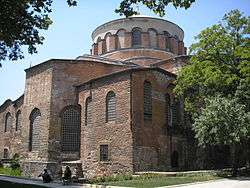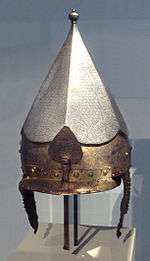Hagia Irene
| Hagia Irene | |
|---|---|
 | |
| Basic information | |
| Location | Istanbul, Turkey |
| Geographic coordinates | 41°0′35″N 28°58′52″E / 41.00972°N 28.98111°ECoordinates: 41°0′35″N 28°58′52″E / 41.00972°N 28.98111°E |
| Affiliation | Eastern Orthodox |
| Status | Museum |
| Architectural description | |
| Architect(s) | Unknown |
| Architectural type | Church |
| Architectural style | Byzantine |
| Groundbreaking | 4th century |
| Specifications | |
| Materials | Brick, Stone |
Hagia Irene or Hagia Eirene (Ancient Greek: Ἁγία Εἰρήνη, Byzantine Greek pronunciation: [aˈʝia iˈrini], "Holy Peace", Turkish: Aya İrini), sometimes known also as Saint Irene, is an Greek Eastern Orthodox church located in the outer courtyard of Topkapı Palace in Istanbul, Turkey. The Hagia Irene today operates as a museum and concert hall.
History
Naming
The church was dedicated by Constantine to the peace of God, and is one of the three shrines which the Emperor devoted to God's attributes, together with Hagia Sophia (Wisdom) and Hagia Dynamis (Power).[1]
Church
The building reputedly stands on the site of a pre-Christian temple. It ranks, in fact, as the first church built in Constantinople. Roman emperor Constantine I commissioned the first Hagia Irene [Reference?] church in the 4th century. It served as the church of the Patriarchate before Hagia Sophia was completed in 360. From May to July 381 the First Council of Constantinople took place in the church. It was burned down during the Nika revolt in 532.[2] Emperor Justinian I had the church restored in 548.
Heavily damaged by an earthquake in the 8th century, it dates in its present form largely from the repairs made at that time. The Emperor Constantine V ordered the restorations and had its interior decorated with mosaics and frescoes. Hagia Irene is the only example of a Byzantine church in the city which retains its original atrium. A great cross in the half-dome above the main narthex, where the image of the Pantocrator or Theotokos was usually placed in Byzantine tradition, is a unique vestige of the Iconoclastic art; presumably it replaced earlier decoration. The church was enlarged during the 11th and 12th centuries.
The church measures 100 m × 32 m. It has the typical form of a Roman basilica, consisting of a nave and two aisles, divided by columns and pillars. It comprises a main space, a narthex, galleries and an atrium. The dome is 15m wide and 35m high and has twenty windows.
Arsenal
After the conquest of Constantinople in 1453 by Mehmed II, the church was enclosed inside the walls of the Topkapi palace. The Janissaries used the church as an armoury. It was also used as a warehouse for war booty. During the reign of Sultan Ahmet III (1703–1730) it was converted into a weapons museum.
In 1846, Marshal of the Imperial Arsenal, Ahmed Fethi Paşa, made the church into a military antiques museum.[3] It was used as the Military Museum from 1908 until 1978 when it was turned over to the Turkish Ministry of Culture.
Concert hall
Today, the Hagia Irene serves mainly as a concert hall for classical music performances, due to its extraordinary acoustic characteristics and impressive atmosphere. Many of the concerts of the Istanbul International Music Festival have been held here every summer since 1980.
In 2000, the Turkish haute couture designer Faruk Saraç produced a special show here. A collection of 700 designed pieces inspired by the Ottoman sultans, including the robes of 36 sultans ranging from Osman Gazi, the founder of the Ottoman Empire to the last sultan, Mehmed VI, were on display. The show was accompanied by music and the story of the sultans' lives and demonstrations of Ottoman-era dancing.
For many years, the Hagia Irene was only accessible during events or by special permission, but the museum has been open to the public every day except Tuesday since January 2014.[4]
Gallery
- Hagia Irene
 The apse of the church with cross
The apse of the church with cross Ground plan of the church
Ground plan of the church Ottoman helmet, with markings of Saint-Irene arsenal, Constantinople, circa 1520. Musée de l'Armée.
Ottoman helmet, with markings of Saint-Irene arsenal, Constantinople, circa 1520. Musée de l'Armée.- Hagia Irene with Hagia Sophia at the back
See also
References
- ↑ Janin, pg. 106
- ↑ Allan Doig, Liturgy and Architecture: From the Early Church to the Middle Ages, (Ashgate Publishing, 2008), 65.
- ↑ Museums and Narratives of Display from the late Ottoman Empire to the Turkish Republic, Wendy Shaw, Muqarnas, Vol.XXIV, (Brill, 2007), 256.
- ↑ "Hagia Irene Museum Opened". Topkapi Palace Museum. 6 January 2014. Retrieved 10 October 2014.
Bibliography
- Akşit, I. (2005). Hagia Sophia: Akşit Kültür ve Turizm Yayincilik. ISBN 975-7039-07-1.
- Davis, Fanny (1970). Palace of Topkapi in Istanbul. ASIN B000NP64Z2.
- Janin, Raymond (1953). "Le Siège de Constantinople et le Patriarcat Oecuménique". La Géographie Ecclésiastique de l'Empire Byzantin (in French). Paris: Institut Français d'Etudes Byzantines. 3rd Vol.: Les Églises et les Monastères (part 1.).
- Kazhdan (ed.), Alexander (1991). "Church of Saint s.v.Irene". The Oxford Dictionary of Byzantium. Oxford University Press. 2nd of 3 vols. ISBN 0195046528.
- Krautheimer, Richard (1984). Early Christian and Byzantine Architecture. New Haven, CT: Yale University Press. ISBN 978-0-300-05294-7.
- Necipoğlu, Gülru (1991). Architecture, ceremonial, and power: The Topkapi Palace in the fifteenth and sixteenth centuries. Cambridge, Massachusetts: The MIT Press. ISBN 0-262-14050-0.
External links
| Wikimedia Commons has media related to Hagia Irene. |